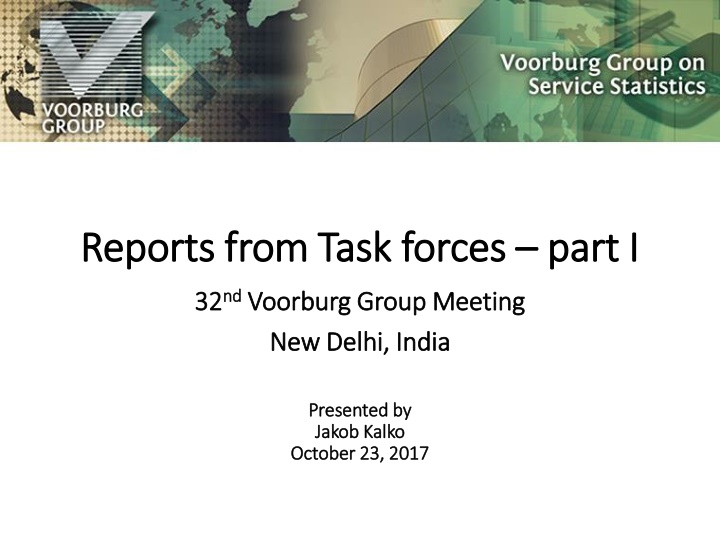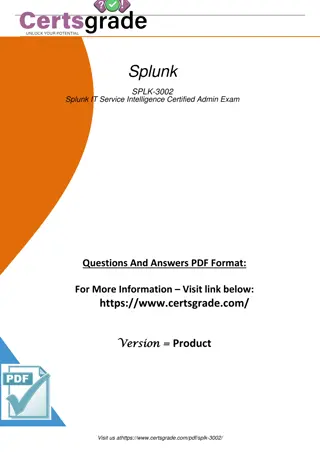
Task Force Reports from 32nd Voorburg Group Meeting in New Delhi, India
Explore the insights and feedback from the Task Force's report presented during the 32nd Voorburg Group Meeting held in New Delhi, India. The session covered cross-cutting topics, updating of documentation, and future agenda items discussed during the meeting.
Uploaded on | 2 Views
Download Presentation

Please find below an Image/Link to download the presentation.
The content on the website is provided AS IS for your information and personal use only. It may not be sold, licensed, or shared on other websites without obtaining consent from the author. If you encounter any issues during the download, it is possible that the publisher has removed the file from their server.
You are allowed to download the files provided on this website for personal or commercial use, subject to the condition that they are used lawfully. All files are the property of their respective owners.
The content on the website is provided AS IS for your information and personal use only. It may not be sold, licensed, or shared on other websites without obtaining consent from the author.
E N D
Presentation Transcript
Reports from Task forces Reports from Task forces part I part I 32 32nd ndVoorburg Group Meeting Voorburg Group Meeting New Delhi, India New Delhi, India Presented by Presented by Jakob Kalko Jakob Kalko October 23, 2017 October 23, 2017
Reports from Task forces Reports from Task forces part I part I The session covers: Cross-cutting topics criteria - feedback from TF Updating of VG-documentation some criteria Future agenda (1st session) summary of feedback on questions distributed in September.
Feedback from TF CC criteria TF- members: Marcus Friden Statistics Sweden Erika Barrera Central Bank of Chile Ramon Bravo INEGI, Mexico Mohan Chutani Ministry of program. and implement., India Working form: email. Work finished mainly by 3. March, was finally underlined 17. October
Feedback from TF CC criteria Purpose: Fulfill part of the working plan in the strategic plan Establish criteria for cross-cutting issues and produce guidance papers . Establishing criteria for cross-cutting issues should keep the group on track, with regard to fulfilling the objectives in the strategic plan and by this be in line with the mission and vision for the group. Or formulated short deal with relevant non-industry-specific issues for the Group
Feedback from TF CC criteria General approach Main areas Sub areas Scope Format Relevancy Boundaries
Feedback from TF CC criteria Measurement of output/turnover Main areas Main areas SPPI Classification issues, services Methodology/conceptual issues Sub areas National account issues Economic Phenomena (eg. globalization)
Feedback from TF CC criteria Guidelines/summary reports Scope Sharing of best practices Sharing of practical experiences Papers presentation Format Poster session
Feedback from TF CC criteria All countries ( in best case) Relevancy Several industries Not covered by other UN city groups Boundaries Not covered by other organizations Where should we draw the line concerning boundaries - overlapping is acceptable, duplicating is not
32 32nd nd Voorburg Group Meeting Voorburg Group Meeting New Delhi, India New Delhi, India Future Agenda Future Agenda Topics on each slide are presented in no particular order!
General Observations General Observations Keep sector papers for complex/rapidly changing industries up to date Cross cutting issues Sharing best practices Don t focus on small industries just for coverage Digital economy, sharing economy, e-commerce Multi-country co-operation important between meetings 10
Largest Needs for VG Input Largest Needs for VG Input/Challenges /Challenges Seasonal adjustment for SPPIs Guidance on adjustments to price when using list prices Cost effective approaches to sample design/improvement Measuring nonmarket industries (vary by country) Use of administrative/alternative data in price indices (not necessarily restricted to prices?) Accounting for distributed ledger technologies More detail on existing practices (sample sizes, methods in use, specific problems) things to be included in the CDF Evolution of services and impact of traditional measurement practices Quality adjustment 11
Largest Needs for VG Input Largest Needs for VG Input/Challenges /Challenges New data sources and informed consent Trade in services Global production measures deflators (FGPs, merchanting, multinational with head quarters in other countries, granular information from large complex firms, transfer prices) Consistent PPIs for B2All vs B2B, B2C (use of CPI), B2G (source for weights?) Immediate classification help (??): Secondary activities and new services that are not part of the definition Inputs to service industries expense detail and how to streamline collection Approaches to manage response burden 12
Largest Needs for VG Input Largest Needs for VG Input/Challenges /Challenges Classification issues: Multiple industries producing multiples products (e.g. Telecommunications) Peer to peer platforms and open sources Secondary activities and new services that are not part of the definition (immediate classification help) (??) Disconnection between economic framework and business accounting need to explain the respondent what we need and why Inputs to service industries expense detail and how to streamline collection Approaches to manage response burden Posting charges of web reporters like Amazon or accommodation sites survey to companies or costumers; B2B versus B2All 13
NSO Issues to Share with VG NSO Issues to Share with VG SPPI during reorganization Transitioning data collection in a matrix environment Measuring service industry products in output Quality change between traditional and online transactions Quality indicators for price indices (and other estimates?) Efficiency and quality gains in base year revision process Health SPPIs 14
NSO Issues to Share with VG NSO Issues to Share with VG Web scraping of internet platforms - Franchises (US) (2 different topics??) Measurement of E-commerce (China) Use of administrative data to set up new industries, new business categories, new business models (China). Deflator application: Three way electronic data exchange between national accounts, prices and volume (Finland) (got it right?) New SPPI questionnaires (short list of services) and results (Poland) 15
New and Alternative Data Sources New and Alternative Data Sources Practical issues negotiating agreements, evaluating quality, data processing and aggregation, monitoring regulation effects on data availability, etc. Government transaction data Tax data Data collected by regulators and business organizations Use of accounting software for gathering data directly from firms. Peer to peer intermediation platforms Web scraping, scanner data, other big data Re-use of micro data from other surveys (CPI?) Internet advertising, search tools, etc. to determine cost per click (CPC) Supplement vs. replace? 16
Possible Revisited Sector Papers Possible Revisited Sector Papers Wholesale and retail trade (margin industries, e- commerce in retail) Computer programming, cloud computing Telecommunications Media industries focusing on digitalization Postal and courier services Business management and consultancy Industries impacted by the sharing economy (Accommodation, Reservation services, Transportation) also in cross-cutting Industries with new technology Intellectual property Legal services 17
Possible Revisited Sector Papers Possible Revisited Sector Papers Market research and public opinion polling. Small industry should it be included ? Head offices. To be included ? According to definition of ISIC 70, only internal transactions Research and development. If this is ISIC 72, we have no sector paper. No useable SPPI experience in 2010 and a large part of activity takes place as internal transactions and within R&D institutions not directed towards open market. ISIC 72 is not by the way not going be included in the STS FRIBS. Suggestion for country reports - adding question to countries: What industries they have reported in previous VG meetings? There have been changes on how they measure output and price? 18
Possible Cross Cutting Issues Possible Cross Cutting Issues Many already covered in previous slides Re-stratification, resampling, rebasing, basket and weight updates (frequency, process, and explaining to users), data sources for weight (SPPIs). Frequency Globalization/digitalization/e-commerce Measuring output, prices, quality adjustment, classification Measuring the sharing economy output, prices, classification also in industries Quality adjustment methods (hedonics?) Alternate data sources (Alternate?? Alternative?) Practical aspects of profiling and collecting data from large/complex companies 19
Possible Cross Cutting Issues Possible Cross Cutting Issues Many already covered in previous slides Impacts of currency exchange and cross border transactions Logistics services, fulfillment centers, intermediaries in service transactions output, price, classification Asymmetries with national accounts Market vs non-market Statistical units Proxy deflators (e.g. ISP) (???) Criteria for validating survey responses Sharing index structures between countries 20
Classification questions chl@un.org


